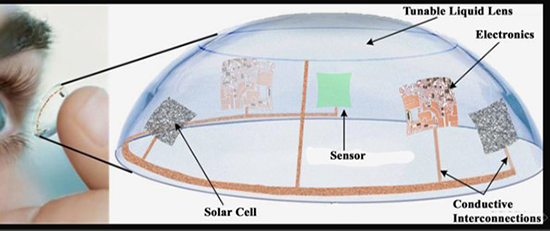Current estimates are that presbyopia affects approximately 1.8 billion people around the world, and as the world population ages (we’re living longer), that number will rise considerably. Contemporary presbyopia correction with contact lenses includes monovision and multifocal lenses. But what if a contact lens could transition from distance to near vision as seamlessly as our younger eyes? Based on the volume of new patent filings and prototypes, accommodating contact lenses are in our future.
According to a paper recently published in Contact Lens and Anterior Eye, there are two hurdles to overcome for an accommodative contact lens. First, the user’s gaze must be tracked for changes in viewing distance, and second is control of the focal length. Approximately 2.00 diopters of additional plus power is needed for near vision. That sounds like a tall order, but innovative solutions are in the works.
 |
What about gaze tracking? For that, we need a different type of lens. Microelectronic sensors embedded in the lens track changes in gaze based on changes in an electrical charge. The changes control the lens optics. Transmission of gaze information to an external device can also control lens power. Like other “smart” contact lenses, these lenses require a power source and an antenna. Contact lenses using liquid crystal displays (LCDs) are in the pipeline, too. Liquid crystals form parallel rods in their natural state. Reorienting the rods with a low voltage electrical charge changes the refractive index of the lens, and so the power.
Patents and patent applications have been filed for these designs, and clinical trials have been proposed, while some already are under way. It will take much more time and trial before lenses like these are available, but as the technology for contact lens materials and microelectronics progresses, they are on a bright horizon.
Learn more about contact lenses of the future with our CE, Therapeutic Contact Lenses and beyond at 2020mag.com/ce.













